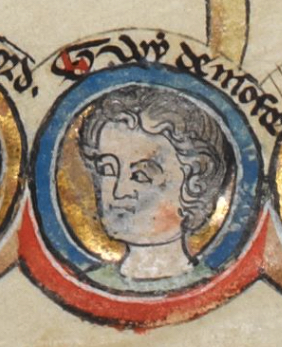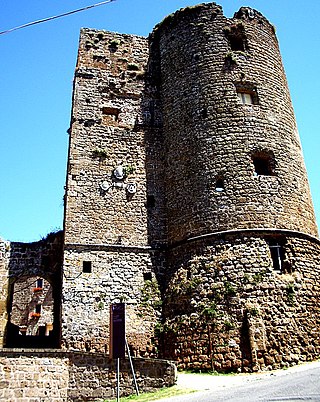Overview
Of probable Lombard origin, they appear in history as counts in the 9th century. The first known count was Hildebrand II (857). Their possession extended to what is now southern Tuscany and northern Lazio regions of Italy.
In 1274, their lands were divided between the County of Santa Fiora and the County of Sovana, which thenceforth were ruled by different branches of the family. After the extinction of the Aldobrandeschi of Sovana, the county was assigned to the Orsini. The Aldobrandeschi heiress of Santa Fiora married into the Sforza family. [1] [2]
The most famous members were: Guglielmo Aldobrandeschi, who lived in the 13th century and is cited by Dante Alighieri as the Gran Tosco ("Grand Tuscan"); Guglielmo's son is also cited in Canto XI of the Purgatorio in the Divine Comedy as an example of a sinner of pride; and Margherita, the last of the Aldobrandeschi of Sovana, who married Guy de Montfort, Count of Nola, and passed rule over Soana to her daughter Anastasia and son-in-law, Romano "Romanello" Orsini and their heirs. [1]

The House of Orsini is an Italian noble family that was one of the most influential princely families in medieval Italy and Renaissance Rome. Members of the Orsini family include five popes: Stephen II (752–757), Paul I (757–767), Celestine III (1191–1198), Nicholas III (1277–1280), and Benedict XIII (1724–1730). The family also included 34 cardinals, numerous condottieri, and other significant political and religious figures. The Orsini are part of the Black nobility who were Roman aristocratic families who supported the Popes in the governance of the Papal States.

The House of Sforza was a ruling family of Renaissance Italy, based in Milan. Sforza rule began with the family's acquisition of the Duchy of Milan following the extinction of the Visconti family in the mid-15th century and ended with the death of the last member of the family's main branch, Francesco II Sforza, in 1535.

Guy de Montfort, Count of Nola (1244–1291) was the son of Simon de Montfort, 6th Earl of Leicester and Eleanor of England.

Pitigliano is a town in the province of Grosseto, located about 80 kilometres (50 mi) south-east of the city of Grosseto, Tuscany, Italy. It is one of I Borghi più belli d'Italia.

Sorano is a town and comune in the province of Grosseto, southern Tuscany (Italy).

Castell'Azzara is a comune (municipality) in the Province of Grosseto in the Italian region Tuscany, located about 120 kilometres (75 mi) southeast of Florence and about 50 kilometres (31 mi) east of Grosseto.

Roccalbegna is a comune (municipality) in the Province of Grosseto in the Italian region Tuscany, located about 110 kilometres (68 mi) south of Florence and about 35 kilometres (22 mi) east of Grosseto.

Santa Fiora is a comune (municipality) in the province of Grosseto, in the Italian region of Tuscany, located about 110 kilometres southeast of Florence and about 40 km (25 mi) east of Grosseto. Santa Fiora borders the following municipalities: Abbadia San Salvatore, Arcidosso, Castel del Piano, Castell'Azzara, Piancastagnaio, Roccalbegna, and Semproniano. It is one of I Borghi più belli d'Italia.

Semproniano is a comune (municipality) in the Province of Grosseto in the Italian region of Tuscany, about 120 kilometres (75 mi) south of Florence and about 35 kilometres (22 mi) east of Grosseto.

Sovana is a small town in southern Tuscany, Italy, a frazione of Sorano, a comune in the province of Grosseto. It is one of I Borghi più belli d'Italia.

The County of Santa Fiora, also known as State of Santa Fiora was a small historical state of southern Tuscany, in central Italy. Together with the county of Sovana, it was one of the two subdivisions into which the possessions of the Aldobrandeschi, then lords of much of southern Tuscany, were split in 1274.

Selvena is a small hill-town, population 578, in southern Tuscany, Italy. It stands at an altitude of 658 metres above sea level some 5 kilometres west of Castell'Azzara; administratively it falls within the comune of Castell'Azzara.

Istia d'Ombrone is a small town in southern Tuscany, Italy, a frazione of the comune of Grosseto.
Anastasia de Montfort, Countess of Nola, was an Italian noblewoman and a wealthy heiress. She was the eldest daughter of Guy de Montfort, Count of Nola, himself the son of Simon de Montfort, 6th Earl of Leicester. She held the title suo jure Countess of Nola after her father's death in 1291. She also held the titles of suo jureDame de Chailly and suo jureDame de Longjumeau. She was the wife of Romano Orsini, Senator of Rome.

Bagnore is a village in Tuscany, central Italy, administratively a frazione of the comune of Santa Fiora, province of Grosseto. At the time of the 2001 census its population amounted to 420.

Castell'Ottieri is a village in Tuscany, central Italy, administratively a frazione of the comune of Sorano, province of Grosseto, in the tuff area of southern Maremma. At the time of the 2001 census its population amounted to 195.

Marsiliana, known also as Marsiliana d'Albegna, is a village in Tuscany, central Italy, administratively a frazione of the comune of Manciano, province of Grosseto. At the time of the 2001 census its population amounted to 246.

Montevitozzo is a village in Tuscany, central Italy, administratively a frazione of the comune of Sorano, province of Grosseto, in the tuff area of southern Maremma. At the time of the 2001 census its population amounted to 106.

Montorio is a village in Tuscany, central Italy, administratively a frazione of the comune of Sorano, province of Grosseto, in the tuff area of southern Maremma.
Nicola Orsini (1331–1399) was a Roman nobleman and man of letters who served the Holy See and the Kingdom of Naples.





















